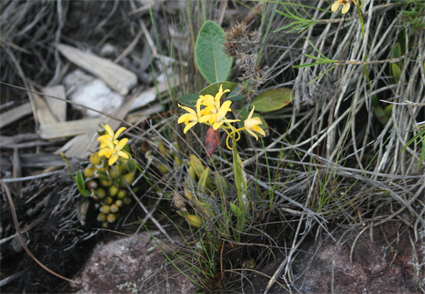Abstract
This study describes and illustrates Cattleya mireileiana (Orchidaceae: Laeliinae), a new species endemic to the Southern Espinhaço Complex near Diamantina, Minas Gerais State, Brazil, where it was found in a few isolated rocky outcrops, sharing habitat with Cattleya rupestres. It is close to three other species: Cattleya bradei, C. briegeri, and C. cruziana. However, the new species differs in the number of nodes present in the pseudobulb components, the size of the diameter, the scent of the flowers and the time of flowering. In addition, its flowers have two unique chromatic characteristics that distinguish it from all other species with yellow flowers in the Parviflorae series: the color of the carinae and the whitish area at the base of the petals and sepals. We provide a detailed morphological description, a distribution map, in situ photographs, and compare it with similar species. We assessed its state of conservation as data deficient (DD), as the only know population consists of at least 150 mature individuals and is outside of an environmentally protected area.
References
<p>Cogniaux, A. (1901) XLVII. <em>Cattleya</em> and <em>Laelia </em>Lindl. <em>In</em>: Martius, C.F.P., Eichler, A.G. & Urban, I. (Eds.) <em>Flora Brasiliensis</em> 3 (5). pp. 188–254, 270–309.</p>
<p>Conceição, A.A., Rapini, A., Carmo, F.F., Brito, J.C., Silva, G.A., Neves, S.P.S. & Jacobi, C.M. (2016) Rupestrian grassland vegetation, diversity and origin. <em>In: </em>Fernandes, G.W. (ed.) <em>Ecology and conservation in mountaintop grasslands in Brazil</em>. Springer International, Switzerland. pp. 105‒127. https://doi.org/10.1007/978-3-319-29808-5_6</p>
<p>Dressler, R.L. (1993) <em>Phylogeny and Classification of the Orchid Family. </em>Dioscorides Press, Portland, 314 pp.</p>
<p>IUCN (2012) IUCN <em>Red List Categories and Criteria</em>. Version 3.1. Second edition. IUCN Publications, Cambridge, 36 pp.</p>
<p>Lindley, J. (1824) Tab. 33 <em>Cattleya labiata</em>. <em>Collectanea Botanica </em>t. 33.</p>
<p>Lindley, J. (1828) Note upon <em>Sophronia modesta, </em>fol. 1129. <em>Botanical Register </em>14: sub. t. 1147.</p>
<p>Lindley, J. (1831) <em>The genera and species of orchidaceous plants</em>. LV. Laelia. London, Ridgways, 115 pp. https://doi.org/10.5962/bhl.title.499</p>
<p>Lindley, J. (1842) <em>Laelia flava</em>. <em>Yellow Laelia</em>. <em>Edwards’s Botanical Register</em> 28: t. 62.</p>
<p>Menezes, E.L.F. & Rosim, M.S. (2019) <em>Hoffmannseggella × jacintiana</em>. <em>L’Orchidophile</em> 222 (50): 217–220.</p>
<p>Pabst, G.F.J. (1973a) Bradea. <em>Boletim do Herbarium Bradeanum</em> 1 (31): 332.</p>
<p>Pabst, G.F.J. (1973b) Bradea. <em>Boletim do Herbarium Bradeanum</em> 1 (31): 333.</p>
<p>Pabst, G.F.J. (1973c) Bradea. <em>Boletim do Herbarium Bradeanum</em> 1 (36): 367.</p>
<p>Pfitzer, E. (1889) Orchidaceae.<em> In: </em>Engler, A. & Prantl, K. (Eds.) <em>Die natürlichen Pflanzenfamilien. </em>Engelmann, Leipzig, pp. 52–224.</p>
<p>Radford, A.E., Dickison, W.C., Massey, J.R. & Bell, C.R. (1974) <em>Vascular Plant Systematics.</em> Harper and Row, New York, Evanston, San Francisco and London.</p>
<p>Rosim, M.S. (2018) <em>Hoffmannseggella guaicuhyensis </em>Rosim sp. nov,<em> Coletânea de Orquídeas Brasileiras</em> 13: 510‒513.</p>
<p>Schlechter, R. (1917a) Die Einteilung der Gattung <em>Laelia </em>und die geographische Verbreitung ihrer Gruppen. <em>Orchis </em>11: 87–96.</p>
<p>Quantum GIS Development Team. (2014) Quantum GIS Geographic Information System. Open Source Geospatial Foundation Project. Program and manual available from: http://qgis.osgeo.org/ (accessed 3 March 2019)</p>
<p>Thiers, B. (2021) [continuously updated]) Index Herbariorum: A global directory of public herbaria and associated staff. New York Botanical Garden’s Virtual Herbarium. Available from: http://sweetgum.nybg.org/science/ih/ (accessed 17 February 2021)</p>
<p>Available from: http://www.iucnredlist.org/ (accessed 19 May 2011)</p>
<p>van den Berg, C. (2005) 293. <em>Cattleya. In</em>: Pridgeon, A.M., Cribb, P.J., Chase, M.W. & Rasmussen, F.N. (Eds.) <em>Genera orchidacearum, 4. Epidendroideae (Part One)</em>. Oxford University Press, Oxford, pp. 213–217.</p>
<p>van den Berg, C. (2008) New combinations in the genus <em>Cattleya </em>Lindl. <em>Neodiversity </em>3: 3–12. https://doi.org/10.13102/neod.31.2</p>
<p>van den Berg, C. (2009) Phylogeny and systematics of <em>Cattleya </em>and <em>Sophronitis</em>. <em>In: </em>Sauleda, R.P. & Sandow, L.A. (Orgs.) <em>Proceedings of the 19th world orchid conference</em>. American Printing Arts, Miami, pp. 319–323.</p>
<p>van den Berg, C. (2014) Reaching a compromise between conflicting nuclear and plastid phylogenetic trees: a new classification for the genus<em> Cattleya </em>(Epidendreae; Epidendroideae; Orchidaceae). <em>Phytotaxa</em> 186 (2): 75–86. https://doi.org/10.11646/phytotaxa.186.2.2</p>
<p>van den Berg, C. (2018) Nomenclatural notes on Laeliinae–VII. New combinations in <em>Cattleya </em>for species and nothospecies originally described in <em>Hoffmannseggella </em>(Orchidaceae). <em>Neodiversity</em> 11: 1–4. https://dx.doi.org/10.13102/neod.111.1</p>
<p>van den Berg, C. (2019) Nomenclatural notes on Laeliinae-VIII. Overlooked new combinations in <em>Cattleya</em>, and new infrageneric nothotaxa. <em>Neodiversity</em> 12: 1–5. https://dx.doi.org/10.13102/neod.121.1</p>
<p>van den Berg, C., Higgins, W.E., Dressler, R.L., Whitten, M.W., Soto Arenas, M.A., Culham, A. & Chase, M.W. (2000) A phylogenetic analysis of Laeliinae (Orchidaceae) based on sequence data from internal transcribed spacers (ITS) of nuclear ribosomal DNA. <em>Lindleyana </em>15: 96–114.</p>
<p>van den Berg, C., Higgins, W.E., Dressler, R.L., Whitten, W.M., Soto-Arenas, M.A. & Chase, M.W. (2009) A phylogenetic study of Laeliinae (Orchidaceae) based on combined nuclear and plastid DNA sequences. <em>Annals of Botany </em>104: 417–430. https://dx.doi.org/10.1093/aob/mcp101</p>
<p>Verola, C.F. & Semir, J. (2007) <em>Hoffmannseggella viridiflora</em> (Orchidaceae, Laeliinae), a new species from Brazilian campus rupestris. <em>Novon</em> 17 (1): 125–129. https://doi.org/10.3417/1055-3177(2007)17[125:HVOLAN]2.0.CO;2</p>
<p>Withner, C.L. (1988)<em> The cattleyas and their relatives, 1: the cattleyas</em>. Timber Press, Portland, 136 pp.</p>
<p>Withner, C.L. (2000) <em>The cattleyas and their relatives, 6: the South American Encyclia species</em>. Timber Press, Portland, 194 pp.</p>


